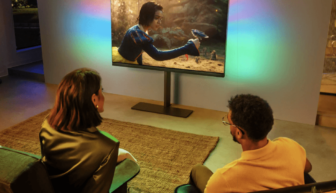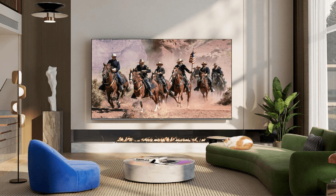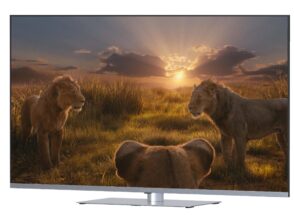Philips 65 inch OLED 959 (65OLED959) Review
Philips is celebrating 20 years of Ambilight and is crowning the technology. With Ambilight Plus, the fascinating wall illumination becomes more sensitive than ever and now works in four depth levels. This experience is rounded off by an OLED Meta panel and genuine 360-degree sound with upfiring speakers.
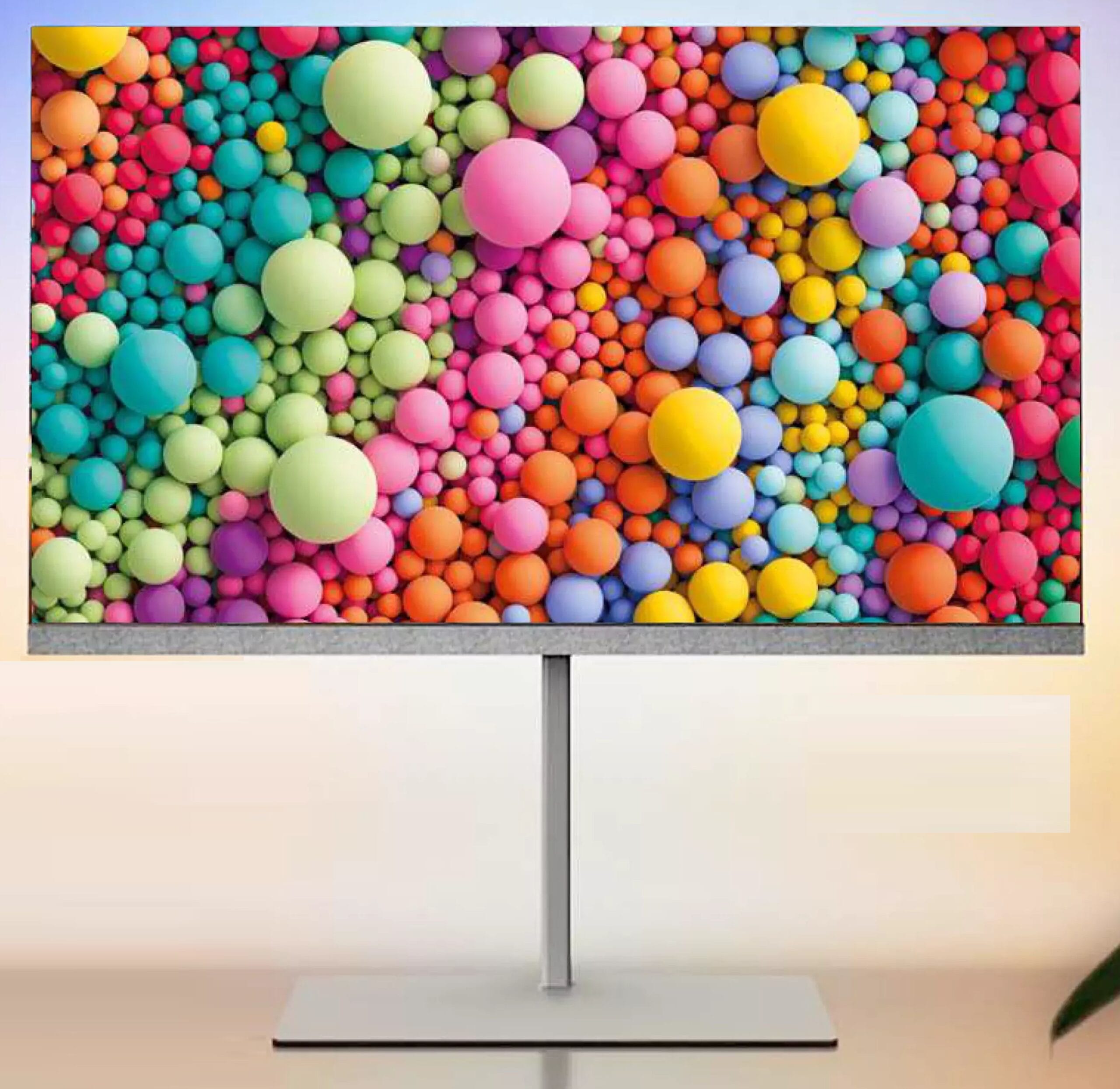
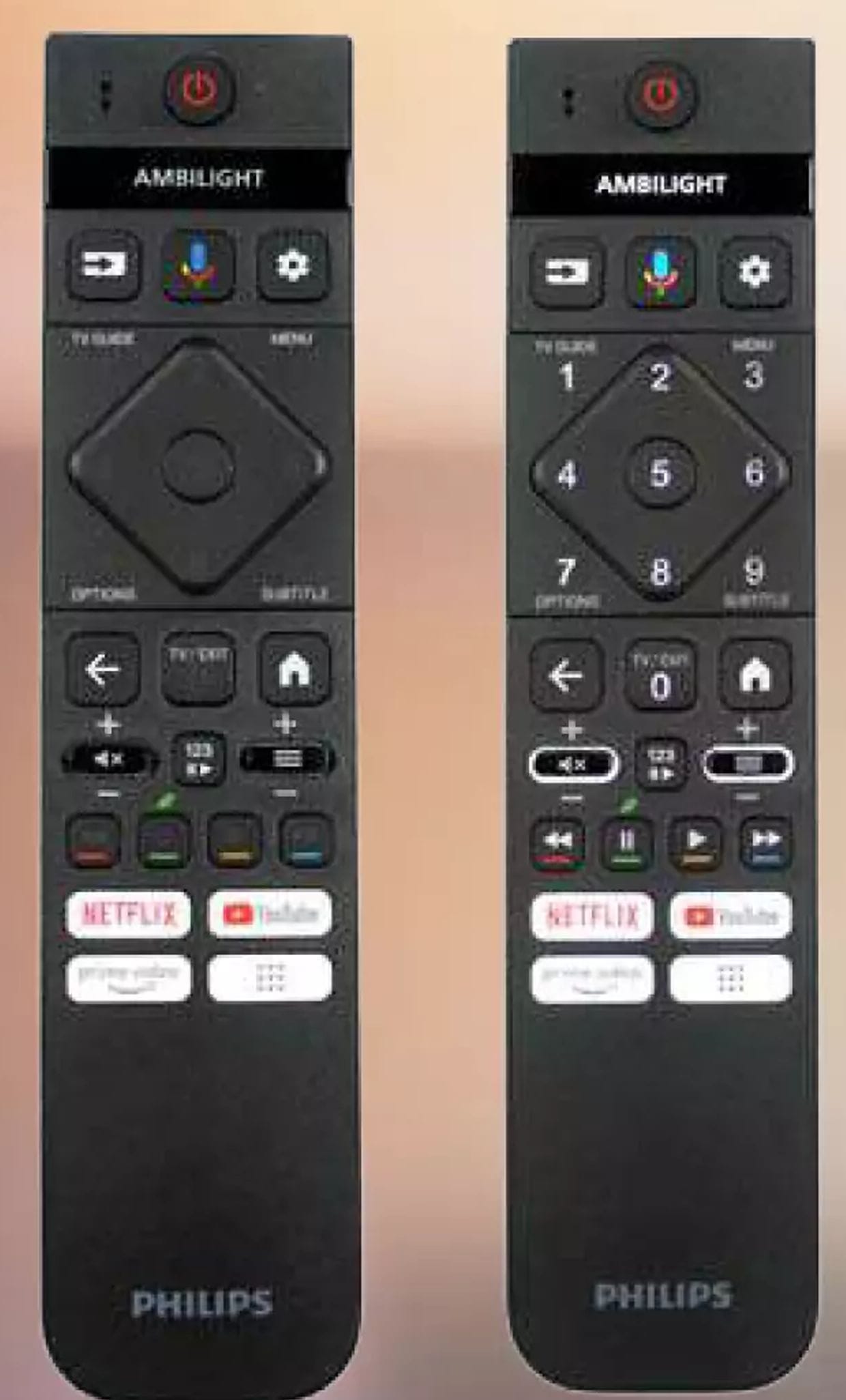
Build and Design
Design is an extremely important criterion for a TV. And here, we are not talking about the appearance of the TV set itself – which, in the case of the Philips 65OLED959, is extremely classy – but about the visual effect of TV, streaming, and gaming content that perfects optical elements in front of and behind the display.
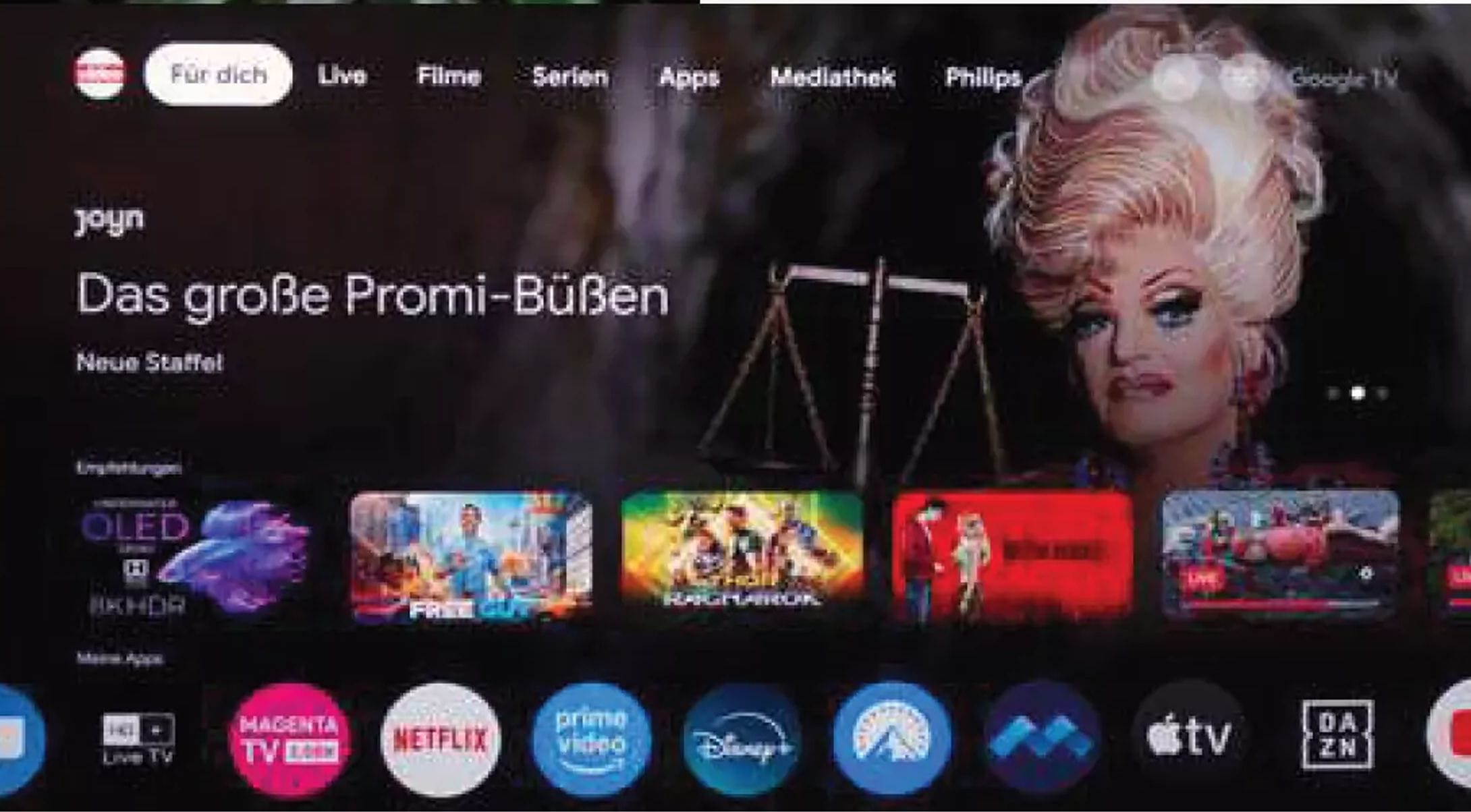
In the new Ambilight Plus, mini lenses ensure that the colors of the vibrant LEDs illuminate the wall behind the TV in a much more precise manner than previously possible. In the screen or, more precisely, in the OLED panel, micro lenses direct the light from the picture cells towards the viewer, thereby improving output, viewing angles, and reflection behavior. The latter is purchased by Philips with the currently best OLED panel from LG Display, called Meta 2.0. The lenses in Ambilight are a Philips invention that, due to many patents, will likely remain exclusive to Philips TVs.
Everything at its finest
The OLED959 is the top product in the portfolio of TP Vision, the manufacturer behind the Philips TV brand. At the moment, it only comes in 65 inches, and this diagonal is also the maximum for the smaller sibling OLED909, which we tested in issue 12/2024. It has the same phenomenal panel but in a more discreet package.
The OLED959, which costs $600 more, offers even more high-quality metal in the chassis and stand, amazing room-filling sound with genuine Atmos, the new Ambilight, and not least an image processing system that is based on two intelligent processors. In addition, the larger sibling includes all the technical refinements of the already very impressive OLED909.
Thus, Google TV is used as the operating system, based on Android 12 and, unfortunately, also with only about 5 gigabytes of usable storage space, of which three were used after all our installations. Nevertheless, the Quadcore A73 with 2 GHz ensures smooth operation of the system. Fans of linear TV will miss the second tuner and the associated recording function or timeshift. They must use the detour via media libraries or cloud recording services like YouTV or SaveTV, which are subscription-based. The same applies to the services of HDTV provider HD+ that can only be tried free of charge for half a year. Philips has built in the hardware to decode and use the added-value functions; this option for private TV channels in HD is installed on request during channel setup. The popular Replay via media libraries is also quickly possible here, meaning you can restart currently running TV programs.
The first two of the four HDMI ports support the full bandwidth of V2.1 (without DSC decompression). For audio, Dolby and DTS are supported in lossless HD, partly up to 192 kHz/24 bit in eight channels. Even Atmos and DTS:X are on board, which is important because the speaker configuration of the 65OLED959 is impressive.
Room for improvement
At first glance, one might wonder why the body of this behemoth is so thick, even though the display panel is just a few millimeters. The answer to the puzzle is the 5.1.2 speaker channels that bring a complete surround setup into the TV. In addition to the front pair and center, which radiate directly to the listener, the surround and upfiring overhead speakers are designed to use reflections from the walls. The high-end specialists at Bowers & Wilkins assisted in tuning this system. Indeed, the 65OLED959 takes the top spot in TV-based cinema sound evaluations – when fed with real Atmos. When limited to stereo and fed music or news dialogues, however, it initially sounded harsh and oversharpened externally. We had to use the AI equalizer to dampen the band around 3 kHz. After that, it sounded very pleasant and natural.
Meanwhile, the LEDs of the three-sided Ambilight are stronger than those of previous generations. So that the lenses can direct the light diagonally outward to illuminate the wall, the optics protrude a bit.
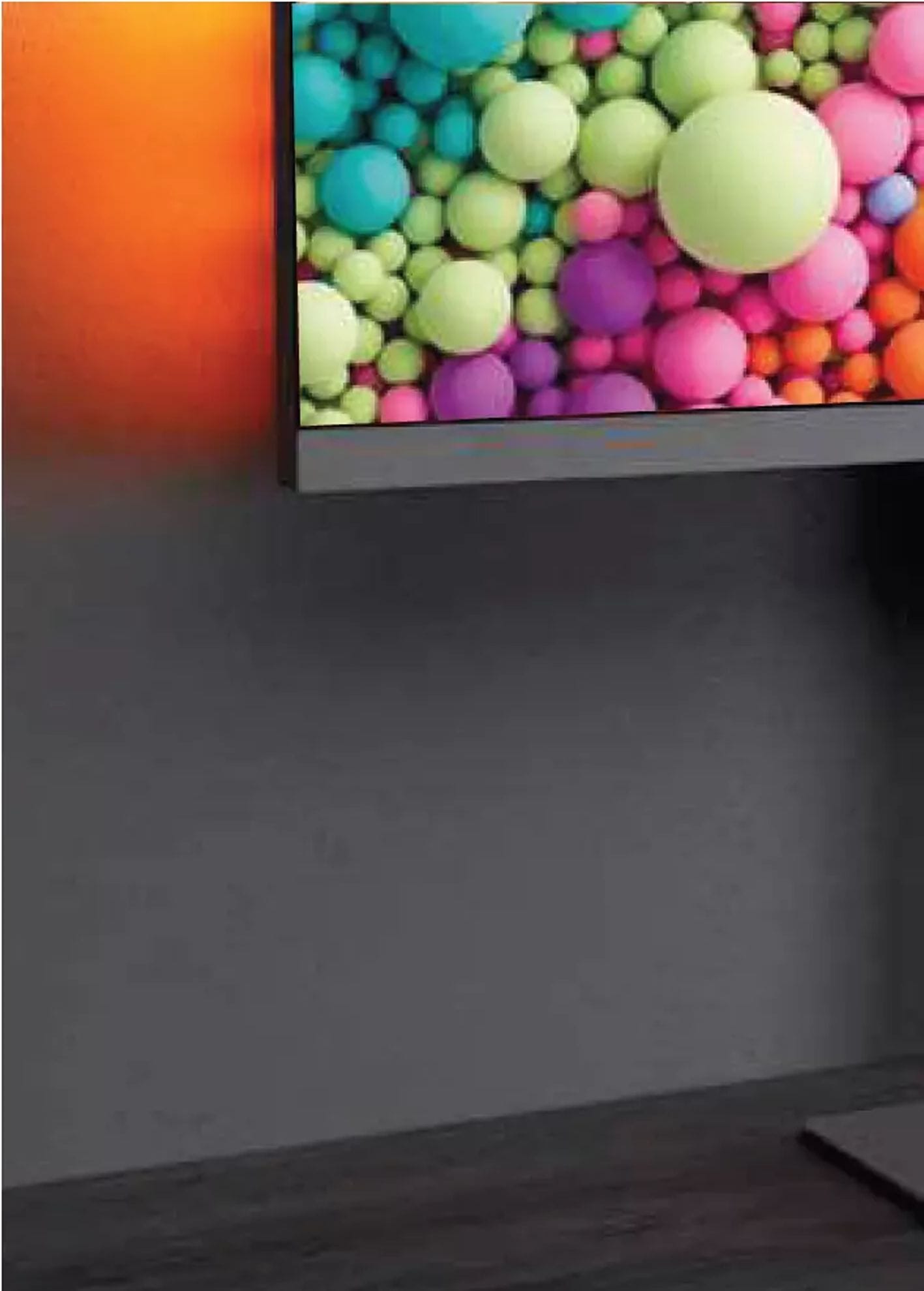
The massive stand weighs more than some entire TVs. However, the heavy frame ensures that this behemoth stands very securely.
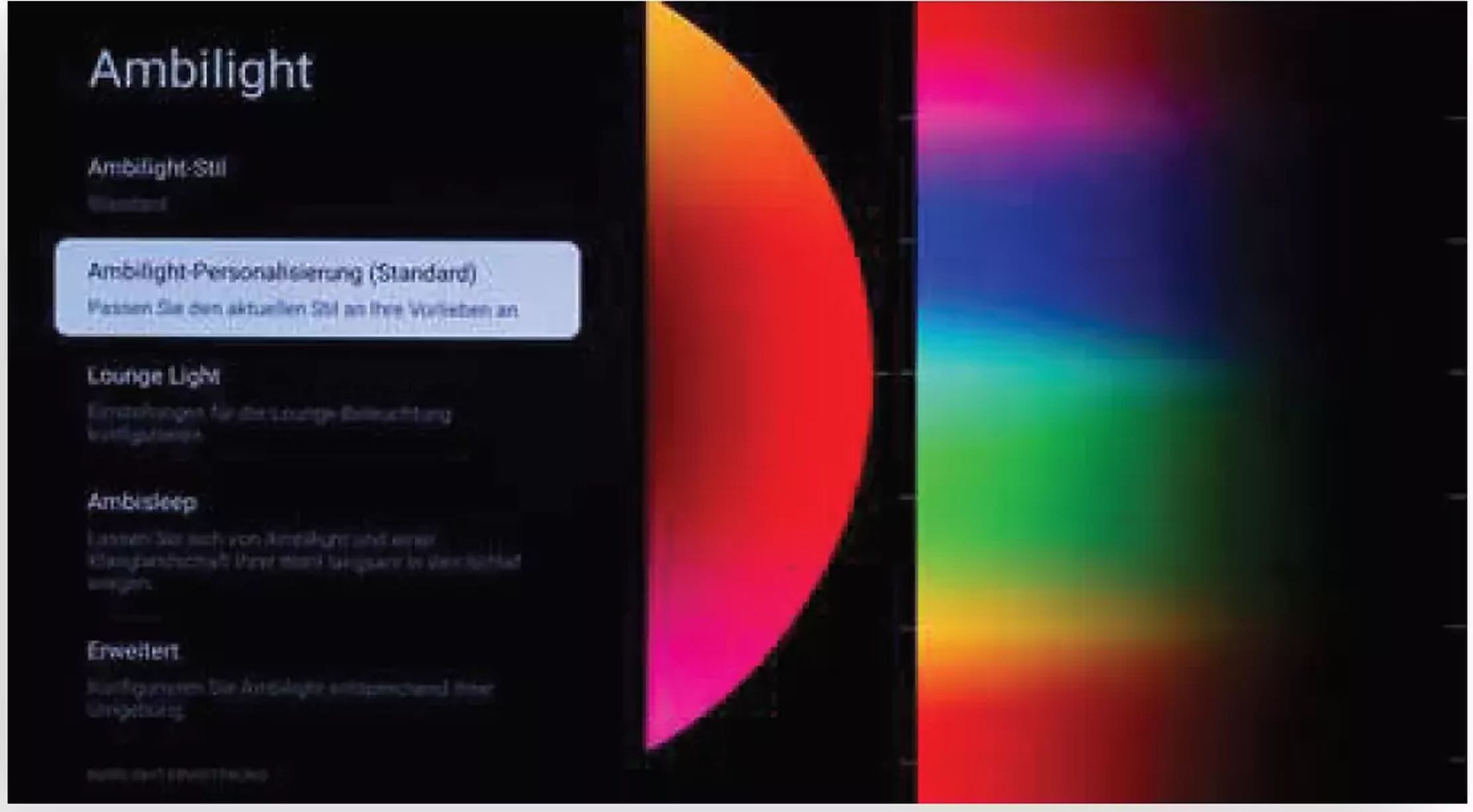
Ambilight Plus is stronger and more precise than the old version. The intensity can be adjusted in three steps. The screenshot on the right shows various usage options.
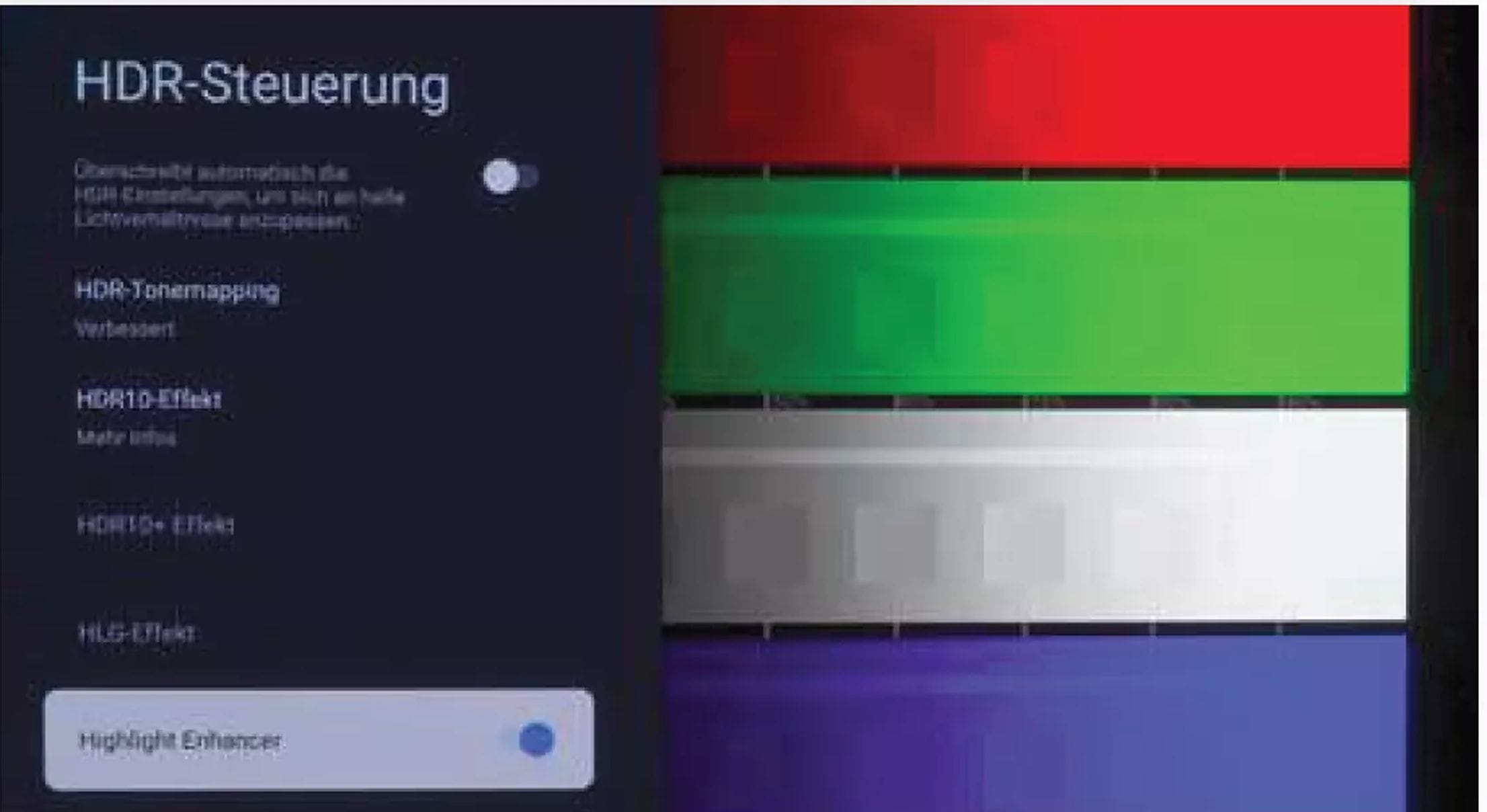
Philips adapts HDR to both static and dynamic metadata and also offers ways to optimize clipping and tone mapping.
OPTIMAL SETTINGS
Picture mode……….Filmmaker
OLED contrast………………..100
Light boost………medium
Video level………………………..98
Black level………………………..50
Gamma……………………………………….4
Saturation………………………………..50
Sharpness………………………………………..0
White point…………………….warm
RGB White…….127,122,83
RGB Black…………….0,0,0
RECOMMENDED VIEWING DISTANCE
TV 3.9 m / DVD: 3.5 m HD 2.3 m / UHD: 1.3 m
GAMING
Philips integrates many features for gaming, from VRR to HGIG, with latencies down to 14 ms. Color isolation and outline function are wild modes.
The 65OLED959 truly reaches the top of TV cinema sound when playing real Atmos. For music or news dialogues, the front initially sounded harsh and oversharpened, so we dampened 3 kHz with the AI equalizer. Afterwards, the result was very pleasant and natural.
Additionally, the LEDs on the three sides of Ambilight protrude more than in previous generations. So the optics slightly stick out to direct the light onto the wall. This makes the back panel less attractive, even though the connection ports and the mounting of the large stand are hidden behind included covers. Cables can be routed through the stand but remain partially visible for a few inches. This TV is not meant to stand in the middle of the room but rather close to the wall, where the Ambilight can unleash its wonderful light show.
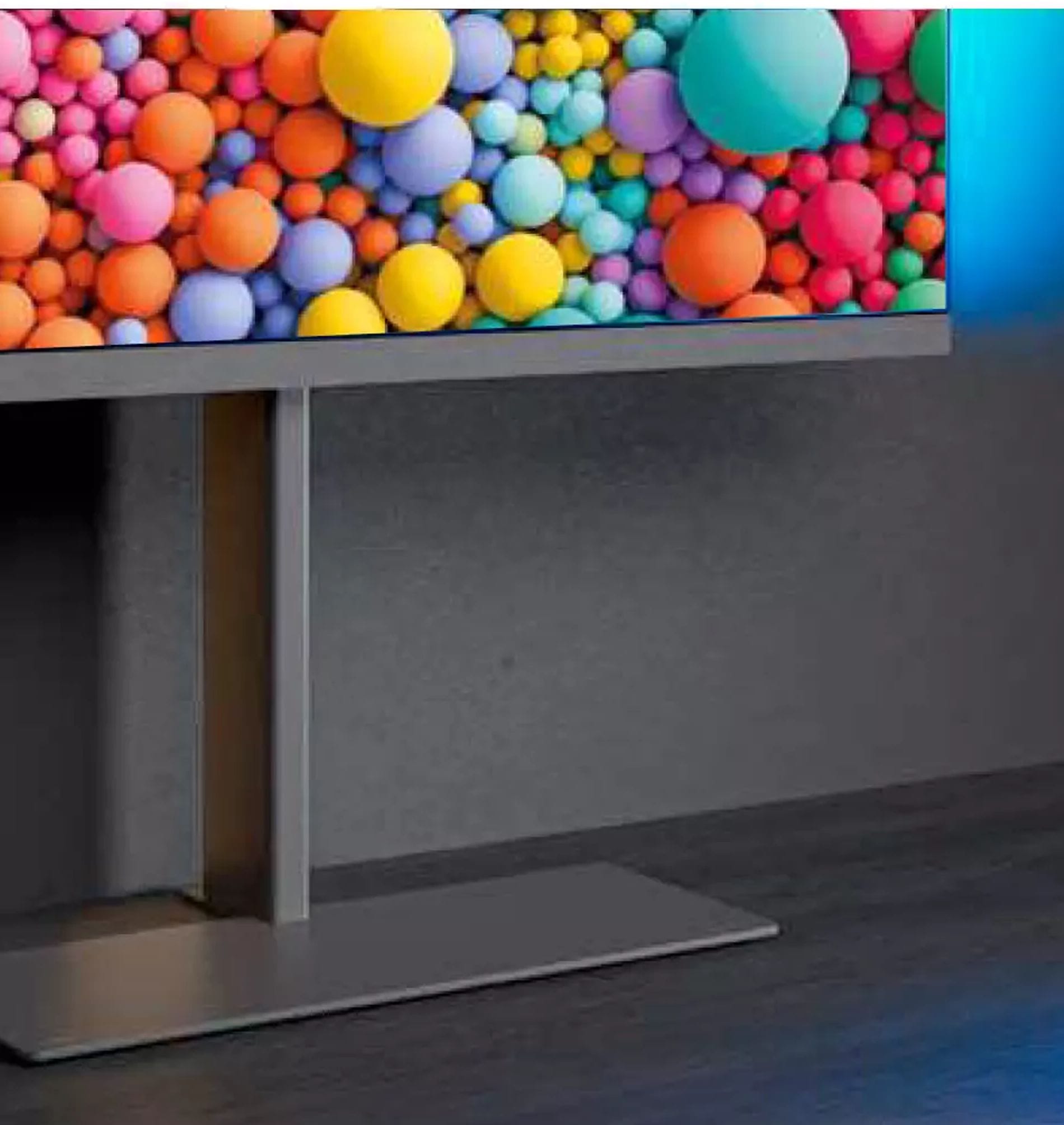
The OLED panel itself is extremely slim, but Philips takes enough room for high-quality drivers that fire even at the ceiling for Atmos 3D sound.
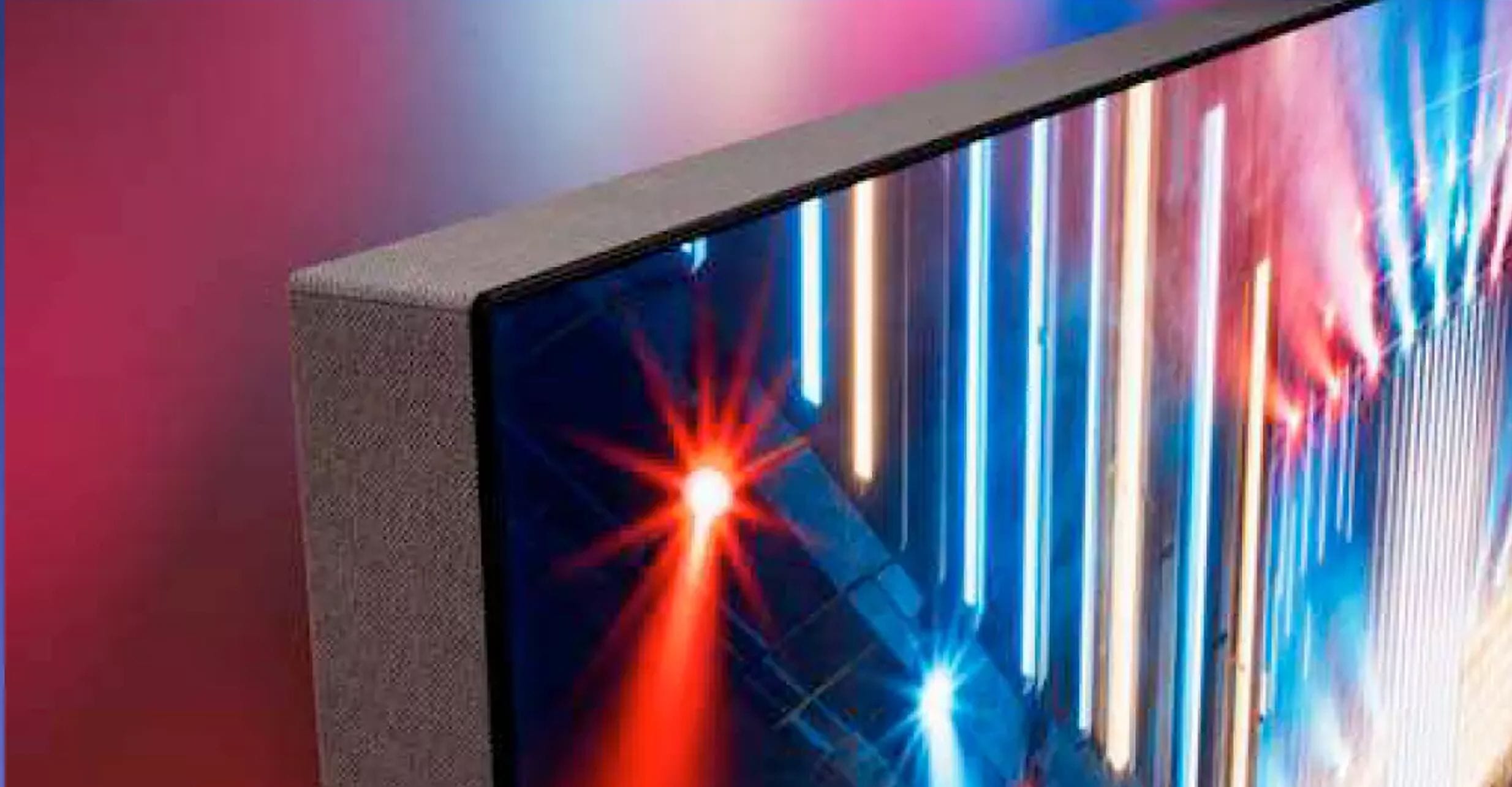
The front, sides, and top edge of the OLED959 are covered with acoustic fabric. It conceals a 5.1.2 sound system from B&W with 102 watts.
This expansion of the colors in the image onto the wall is both loved and hated. Devoted fans would never buy a TV without it. The effects are situationally brilliant for maximizing immersion, but it does not suit every film genre. However, even in a mastering studio there is a calibrated static light behind the display, and Ambilight can provide exactly that too.
P5 in a double pack
Philips is proud of its in-house developed image algorithms in the P5 chip series. Now even an AI co-processor is involved.
All other Philips models only need a single 8th generation P5 video processor with AI. In the 959, a second chip provides even more computing power. According to the manufacturer, thanks to Ambient Intelligence V3, HDR images are now also adapted to ambient lighting conditions, where otherwise dark areas would get lost. The AI Machine Sharpness V2 is supposed to make TV pictures even more detailed and realistic, while Smart Bit Enhancement V3 smooths 8-bit sources to the flowing transitions of 14-bit calculation depth.
And those are just the three aspects in which the dual-engine variant differs from the single-chip version. Even the latter contains over twenty algorithms to perfectly adapt flawless image sources to the conditions of the OLED panel, intelligently polishing weaknesses in videos such as artifacts, blurring, pale colors, weak contrasts, noise, quantization errors, or others.

Speaking of calibration: With Calman Autocal and professional ISF modes, pros can really go to town with picture settings, and the Filmmaker Mode right out of the box delivers acceptable results.
We were, however, shocked by the picture quality from the tuner immediately after installation. In almost all modes, faces are smoothed out and edges are sharpened to extremes, objects almost appear cut out. The culprit is the “Texture Enhancement” picture option, which severely overdoes it and cannot be adjusted, only turned off – something you should definitely do, as it makes the image far more natural. After that, features like noise reduction, de-banding, compression cleanup, and sharpening can be wonderfully utilized and bring a lot of positives.
Overall, you can achieve a professionally neutral or thoughtfully optimized picture performance – with excellent motion compensation. Every source can be set from “originally jerky” to “super-smooth” without artifacts, adjusted to personal preference. The brilliance of the OLED panel is first-class and can be perfectly optimized for any living room thanks to the low reflection factor and ambient light correction. Colors (in Filmmaker) are excellent, HDR is well adapted – not least thanks to Dolby Vision, IMAX, and HDR10+ adaptive.
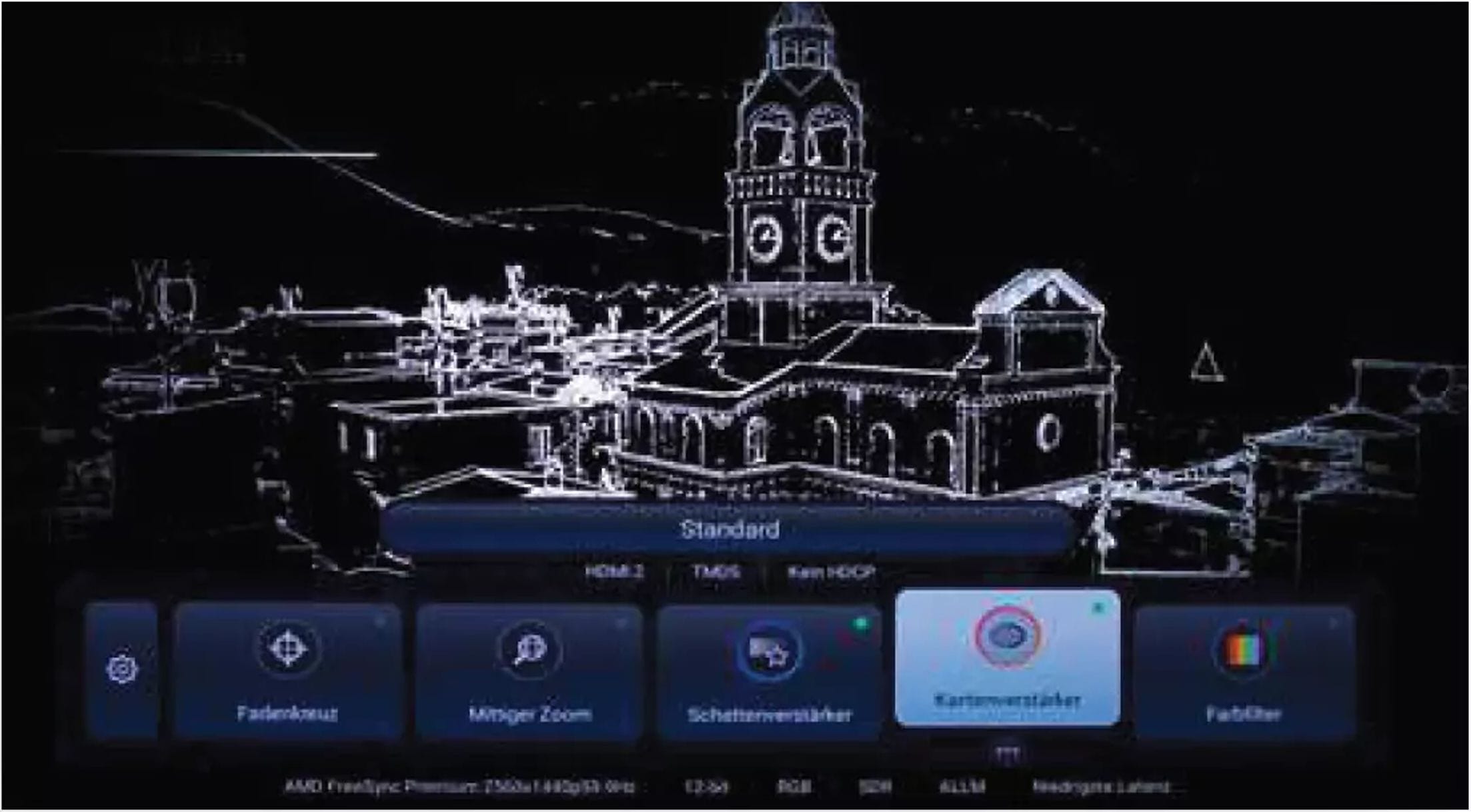
The game menu in Game Mode not only shows HDMI format and frame rate but also leads to special settings, such as this outline mode.

The prepared HD+ decoding in HbbTV Operator Mode is a matter of honor for Philips. As usual, you can try out private HD channels for half a year for free.

The LEDs are split into groups of four. A lens sits in front of each to focus the light.
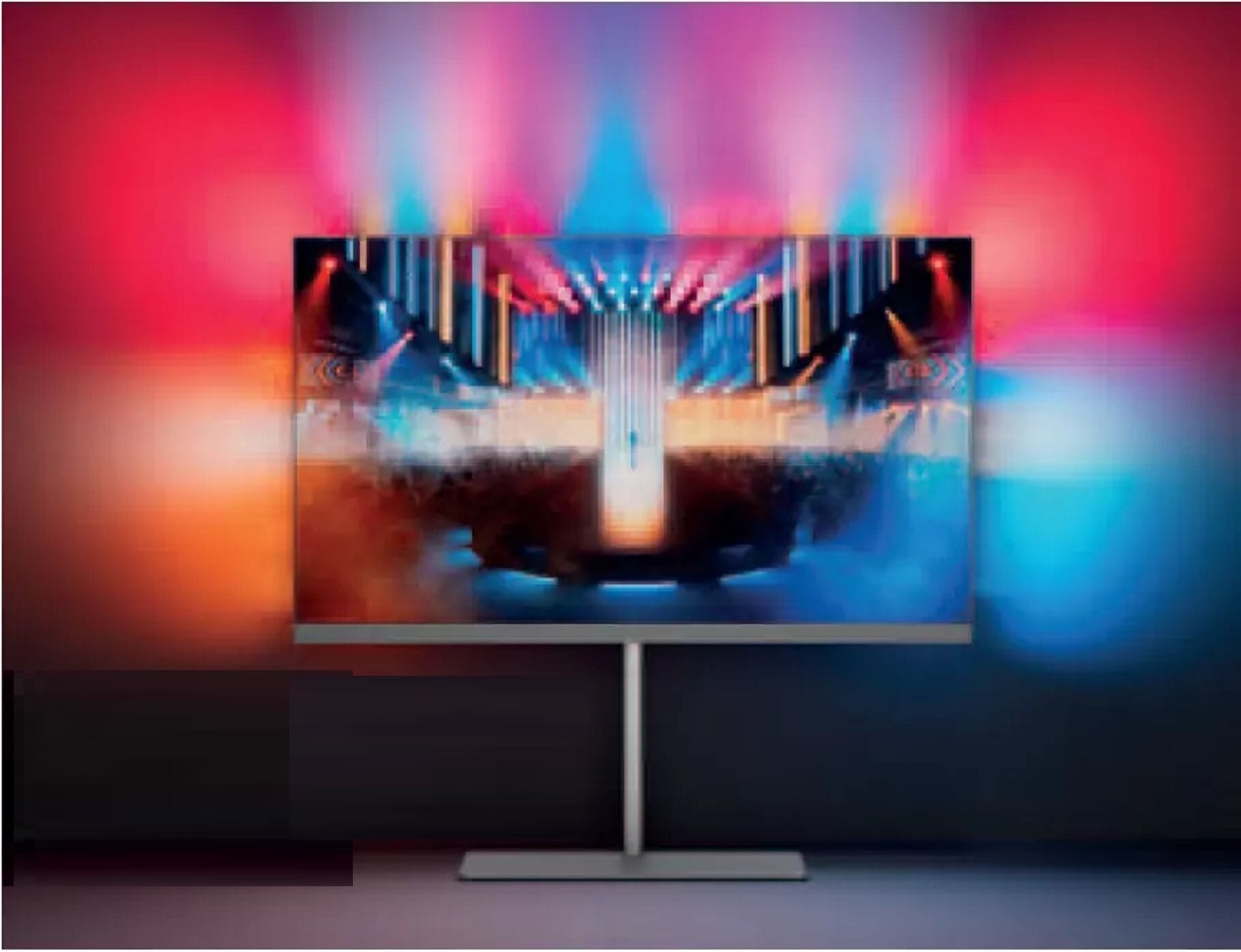
Special optics allow light effects to be projected in a new dimension.
Ambilight Plus
Every year Philips develops its Ambilight further to make it even more impressive.
It all started around twenty years ago with somewhat colorful fluorescent tubes on the sides of a TV back panel. They projected the basic color of the screen content onto the wall behind the TV. Later, additional lights were added on top and bottom, it switched to LEDs and was divided into more and more zones. The level of detail was overdone when nine mini DLP projectors at the back of the TV drew the viewer’s attention too much.
Ambilight is meant to carry the movie’s color dynamics into the room, making you feel darkness in a tunnel, drift through sky-blue clouds, or get a stadium vibe during soccer broadcasts. It affects the subconscious. It takes advantage of the fact that humans can only see a small part of their field of vision sharply, perceiving peripheral elements more vaguely. Therefore, the color-coordinated ambient light creates a much more immersive movie experience.
Ambilight Plus now additionally casts various color effects in four distances from the panel into the room, alongside the three-sided, multi-color ring around the display. To control the impact, you can individually set color intensity, dynamics, and now also fine tuning via the screen menus. There are also effects, for example, for falling asleep (sunset), for music, or to match a wall color.
Conclusion
If you want to enjoy Ambilight in all its glory, you can’t avoid Philips anyway. And the 65OLED959 delights you with the best version so far.
by Roland Seiht
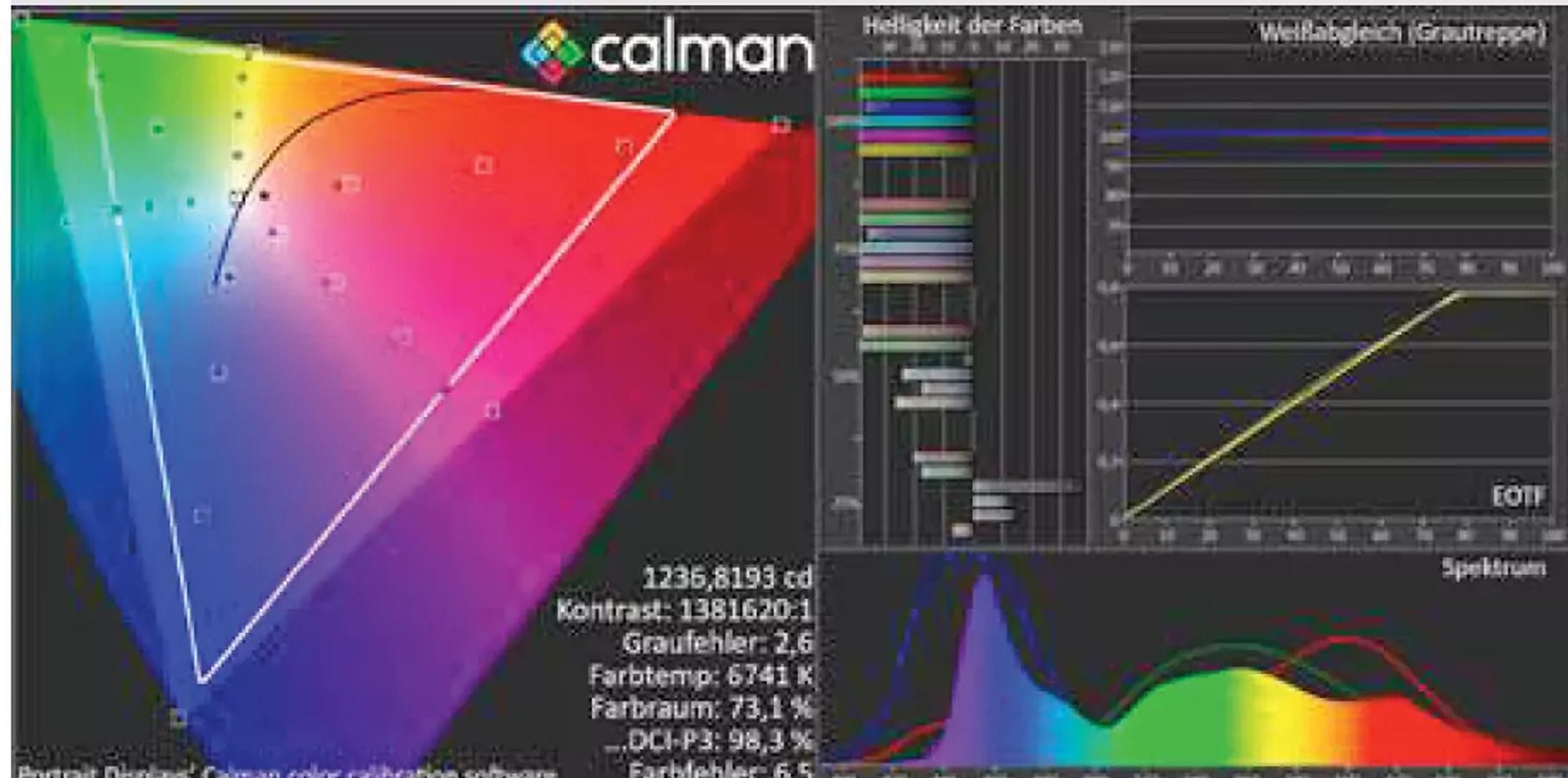
Color and brilliance measurement Ultra HD, HDR, BT.2100, 12-bit
In Filmmaker Mode, everything seems perfectly set from the factory down to the mixed colors – and at brightness levels around 1300 nits. Due to WRGB OLED technology, however, pure colors cannot always be represented in the correct brightness ratio.
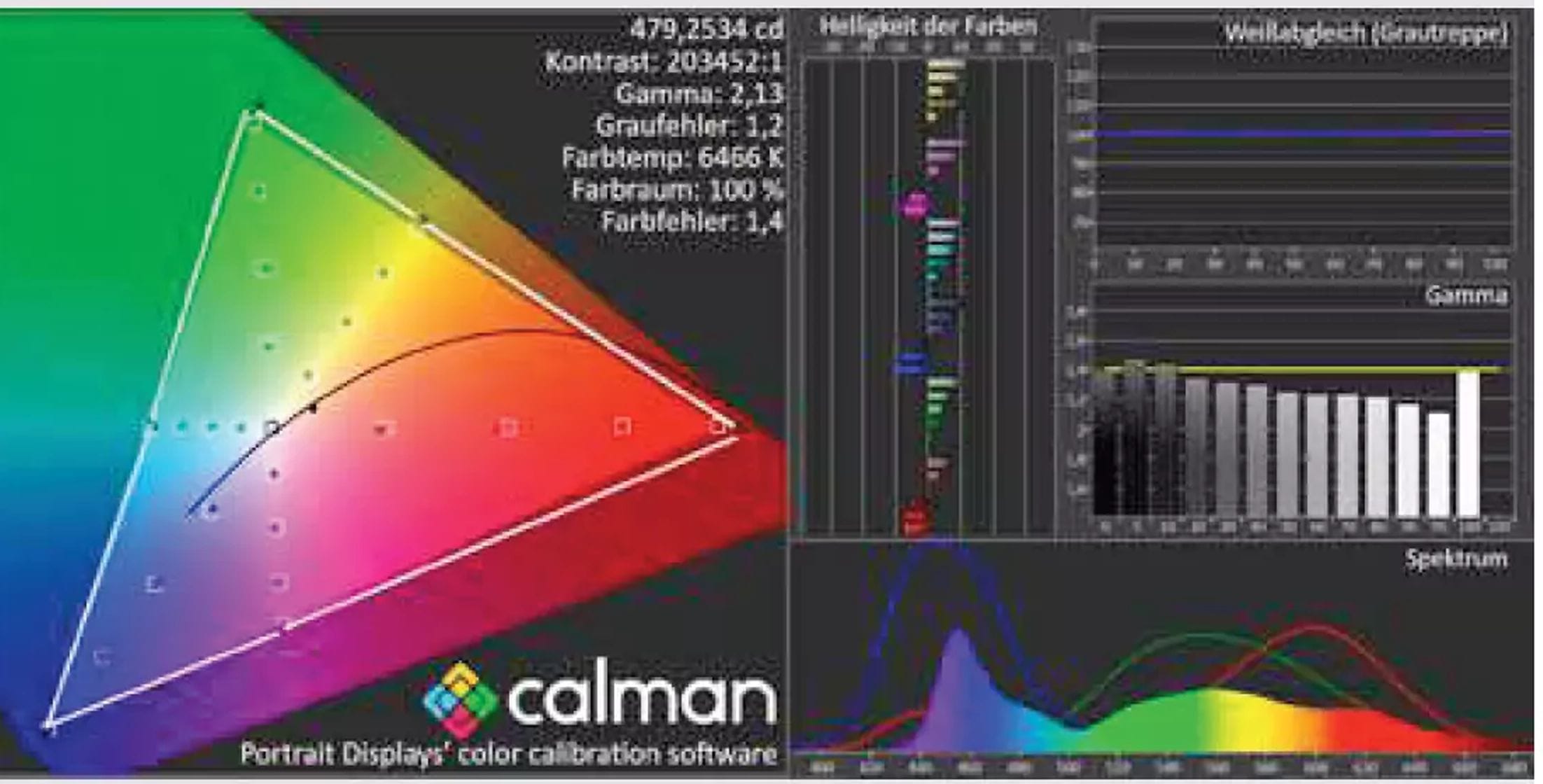
Color and brilliance measurement HDTV, Full HD, BT.709, 8-bit
For classic HDTV material that can go up to 480 nits, RGB balance and color space are very accurate. Only in our measurement, due to the small test window, does the gamma appear too low. Here, it is already being enhanced.

Display under the microscope As with the Philips OLED909, this uses an OLED panel of the Meta 2.0 variant. It is excellently anti-reflective (0.4%) and distributes its light beautifully through micro lenses.
At the same time, it achieves an enormous brightness level.
Philips 65OLED959/12 Specifications
Basic Information
| Specification | Details |
|---|---|
| Manufacturer | Philips |
| Model | 65OLED959/12 |
| Price | €4,300 / $4,600 |
| Website | www.philips.com |
| Dimensions (W × H × D) | 145 × 134 × 38 cm |
| Weight | 45 kg |
Measurements
| Parameter | Value |
|---|---|
| Dimensions (W × H × D) | 145 × 134 (87) × 38 (5.8) cm |
| Screen Diagonal / Weight | 164 cm / 45 (29 kg) |
| Contrast ISO / In-picture / Dynamic | 1552 / 246080 / >1 million |
| Area / Peak White / HDR (cd) | 227 / 481 / 1,436 |
| Gamma / Deviation from Ideal | 2.34 / 2.1% |
| Color Temperature / Deviation | 6,422 K / 1.3% |
| Color Space HDTV / HDR-BT.2020 | 100% / 74% |
| Uniformity / Color Distribution | 95% / 99% |
| Latency Film / Game Mode | 136 ms / 14 ms |
| Power-on / Channel Switching Time | 8 s / 3.1 s |
| Power Consumption (Max. Film / Standby) | 248 W / 115 W / 0.3 W |
Connections
| Type | Specifications |
|---|---|
| Tuner | Analog, DVB‑T, DVB‑C, DVB‑S (1 each) |
| IP Tuner / CI+ | Android Apps, 1 CI+ slot |
| HDMI / Component / AV‑in | 4 HDMI, – Component, – AV-in |
| USB / Network / WLAN | 2 USB (1 USB 3.0), 1 Network port, Wi-Fi ax |
| Audio Output | Optical, Subwoofer, Headphones, Bluetooth 5.2, eARC, DTS PlayFi |
| Special Features | HD+ integrated |
Features
| Feature Category | Details |
|---|---|
| Backlight / Adjustable | OLED+ / Yes |
| Light Sensor / Image Content | No / Yes |
| Refresh Rates / Backlight Blinking | 100 Hz / 200 Hz / Yes |
| High Dynamic Range (HDR) | DV, HDR10+ AD, HLG, IMAX |
| Filmmaker Mode / ALLM / HGIG | No / Yes / Yes |
| G‑Sync / FreeSync / VRR | Compatible / Premium / 40–144 Hz |
| FPS Support (2K / 4K / 8K) | 144 / 144 / – |
| Color Calibration | Fully calibratable |
| RGB Gain + Offset / 10p / 20p | No / Yes |
| Gamma / Noise / Artifact Filter | No / Yes |
| Media Playback | USB, Miracast, Chromecast |
| DLNA Home Network | Client, Renderer |
| HbbTV / Operating System | No / Google TV (Version 12) |
| Smart‑TV Apps | A, Ap, D, Di, G, H, J, M, Mx, N, P, R, Ra, S, Sp, W, Y, Z |
| Voice Control / Smartphone App | Google / Google |
| Hard Drive for Recordings / via USB | No / No |
| Accessories | – |
Extras
- All‑around Ambilight
- Dolby Atmos
- DTS:X
- DTS PlayFi
- Sound by B&W
- Rechargeable Remote Control
- Pop‑up Special Keys
- CalMAN‑ready
- Matter Compatibility
- Control4 Integration
- Audio Room Calibration
Overall Verdict
Picture Quality Ratings
| Category | Max Score | Achieved Score | Final Score |
|---|---|---|---|
| Overall | 510 | 488 | 9.6 |
| TV Reception | 50 | 47 | 9.4 |
| High Definition | 75 | 74 | 9.9 |
| Ultra High Definition (+HDR) | 85 | 89 | 10.0 (capped) |
| Contrast | 80 | 75 | 9.4 |
| Sharpness | 60 | 57 | 9.5 |
| Color Reproduction | 60 | 58 | 9.7 |
| Uniformity / Viewing Angle | 40 | 36 | 9.0 |
| Picture Enhancement | 45 | 44 | 9.8 |
| Sound Quality | 60 | 55 | 9.2 |
| Features | 260 | 217 | 8.4 |
| Tuner | 65 | 47 | 7.2 |
| Ports / Communication | 85 | 71 | 8.4 |
| Media / Smart‑TV / Gaming | 70 | 54 | 7.7 |
| Misc. / Ecology | 50 | 45 | 9.0 |
| Operation | 105 | 92 | 8.8 |
| Menu Design / Handling | 25 | 18 | 7.2 |
| Setting Options | 40 | 40 | 10.0 |
| Installation | 15 | 14 | 9.3 |
| Remote Control | 25 | 20 | 8.0 |
| Build Quality | 80 | 80 | 10.0 |
| Look & Feel | 25 | 25 | 10.0 |
| Materials | 55 | 55 | 10.0 |
+ First device with Ambilight Plus
+ Very high-quality craftsmanship
+ OLED panel Meta 2.0
+ Real 360° Atmos sound
+ Dolby Vision (Gaming) and HDR10+ adaptive
+ AI image processing with two processors
+ DTS Play-Fi and room calibration
– Single tuner without recording function
– RGB PC playback not maximally color-sharp
– little storage space for Google TV 12
OUTSTANDING (9.3 / 10 points)
Philips Ambilight TV OLED+959 | OLED+ | The Best Home Theatre OLED TV
Go deeper into the action, the emotion and the music with this bright #OLED+ TV. With 4-sided #Ambilight, you get a more thrilling ...



